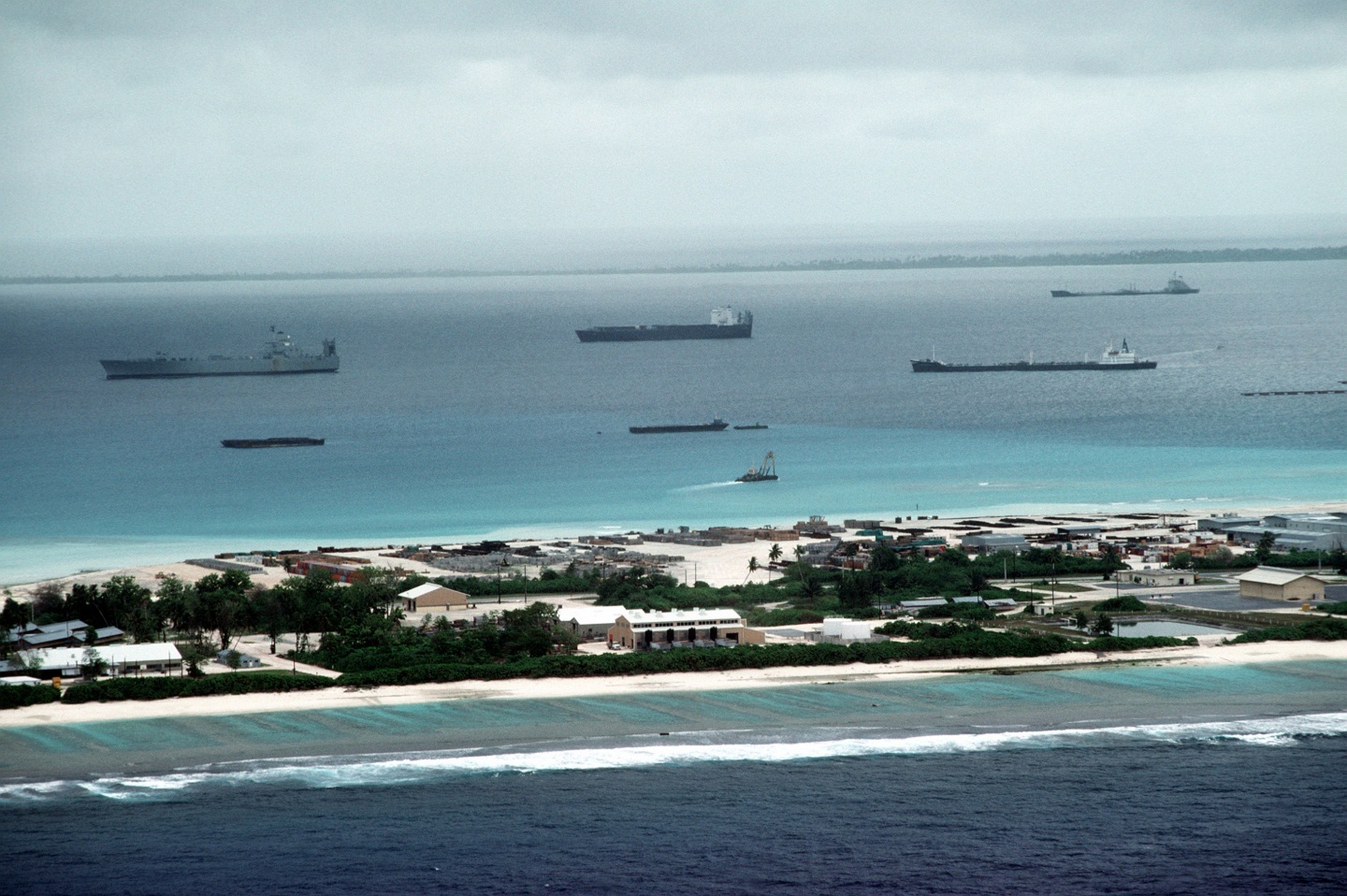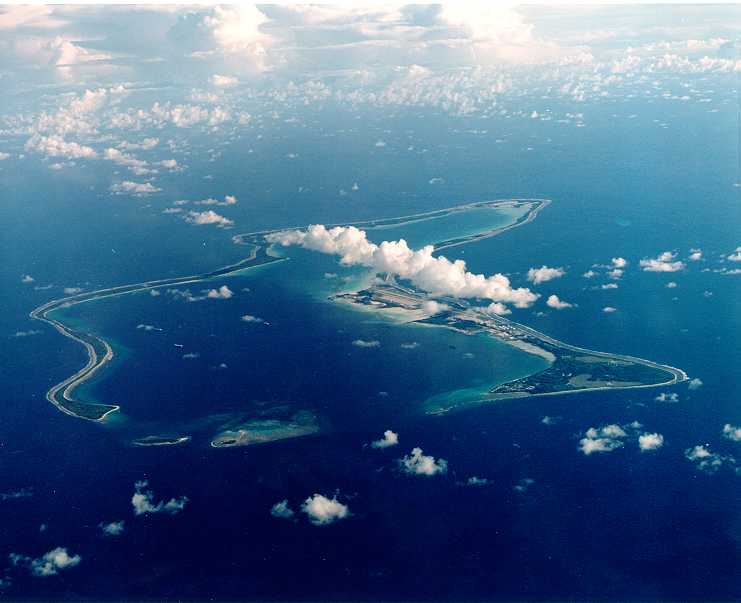.io is one of the fastest-growing top-level domains on the internet, a particular favourite among start-ups and technology companies. It's also one of the most expensive. To the ear of the tech-savvy, “io” sounds like “input/output”, and it’s used for everything from business software and databases to bitcoin and blogs. But like all the other domains we’ve looked at, .io is also a place: a country-code top-level domain, or ccTLD, which refers to a particular place on the Earth's surface. In this case, that place is the British Indian Ocean Territory, a remote but strategically-important scattering of islands in the middle of the Indian Ocean, also known as the Chagos Archipelago. It consists of seven atolls and over 1,000 tiny islands, and not many people have ever heard of it.
The British Indian Ocean Territory (BIOT) was created in 1965, when the British government legally separated the archipelago from the colony of Mauritius, which had been part of the British Empire since 1810. In 1967, when Mauritius gained its independence, Britain hung on to its new territory. The plan was pre-meditated: for some time, the British and US governments had been quietly looking for a “clean” island to use as a base for stationing troops and listening posts in the Indian Ocean. With its central location and deep anchorages, the BIOT was perfect - apart from the fact that people already lived there.
The Chagos had a population of some two thousand inhabitants, known as Ilois - French creole for “islanders” - or Chagossians, who had lived on the islands, first as slaves and later as free plantation workers, for generations. Although they knew no other home, they could not be allowed to remain on the islands.
The British attitude to the Chagossians was articulated in a diplomatic cable of 1966 which dismissively referred to them as “some few Tarzans or Men Fridays”, and over the next few years they were forcibly removed from the islands and dumped on the docks of Mauritius and Seychelles, where most of their descendants still live in poverty today. Their history, and that of the secret deal between the US and Britain to remove them, is told in John Pilger’s film Stealing a Nation.
To add insult to injury, in 2010 the Chagos Marine Protected Area, covering the entirety of the BIOT was declared as “the largest marine preserve in the world”. While it was described by the British government at the time as a move to preserve the unique environment of the Chagos, a diplomatic cable subsequently released by Wikileaks quoted a British minister declaring that the marine preserve was “the most effective long-term way to prevent any of the Chagos Islands' former inhabitants or their descendants from resettling in the BIOT.” A small community of Chagossians in the UK continues to fight for their return to the islands, which has been repeatedly blocked by the UK government.
The reason the British Government is so keen to keep the Chagos Archipelago free of Chagossians is the same as it was in 1964: to preserve its use as a US military base. American Naval personnel first arrived on Diego Garcia, the largest of the BIOT islands, in 1971. Since then the island has hosted NSA and GCHQ listening posts, supported the invasions of Afghanistan and Iraq, and provided prison facilities and a rendition staging post for the CIA's torture programme - all from British territory.
Diego Garcia is a case study in the ways in which secret regimes of surveillance and rendition distort geographical space. It's history is one of secret agreements and secret abuses, where the deliberate obscuration of information leads directly to the obscuration of people, and to the violence done to them.

None of this history is visible from .io, which was assigned to Internet Computer Bureau Ltd, a small company based in Bournemouth, UK, in 1997. Before 1998, the domain name system was administered by Jon Postel at the University of Southern California, and its decisions were not a matter of public record (see the story of .scot for more on the history of DNS). ICB Director Paul Kane is also a DNSSEC “keyholder”, one of seven people around the world entrusted with ensuring the security of the domain name system, who meet in California every few months to reissue the cryptographic codes which keep the web running. (Read James Ball’s article on the keyholders at the Guardian).
Paul Kane has previously described domain names as “national assets” and ICB has been at the forefront of the privatisation of these assets, being the registrar for .ac and .sh, the ccTLDs for the British territories of Ascension Island and St Helena in the South Atlantic, as well as .tm, the ccTLD for the oppressive, autocratic nation of Turkmenistan. Responding to questions from Gigaom in 2014, Kane claimed that “profits are distributed to the authorities for them to operate services as they see fit” and that “Each of the overseas territories has an account and the funds are deposited there because obviously the territories have expenses that they incur and it’s offsetting that.”
According to repeated statements from the British Government, the assertion that domain name sales benefit the territories they originate from isn’t true. In response to Parliamentary questions and to Freedom of Information requests the UK government has stated: “There is no agreement between the UK Government and ICB regarding the administration of the .io domain.”
When contacted for this essay, Paul Kane responded that “I’m a techie. We deliver exemplary service to the global community and I just want to stay doing what we’re very competent at doing and not be involved in the fray that’s ongoing.” Such is the state of internet governance.

.io is a place, but you can’t go there, unless you’re serving in the military, sailing your own yacht, or in chains. The only way the rest of us can reach it is through the internet. sure.io is the telecommunications provider to Diego Garcia, and their network is the only accessible one on the islands: the only .io server registered in BIOT itself. The only thing that can touch it is a traceroute, a log of the waypoints along a data path:
Start: 16 Jun 2015 12:27:34
Find route from: otago.home
Host Names truncated to 32 bytes
1 bthomehub.home (192.168.1.254 ): 2.039 8.101 6.231
2 AS2856 217.32.146.70 (217.32.146.70 ): 17.791 135.434 16.649
3 AS2856 217.32.146.110 (217.32.146.110 ): 137.041 38.705 15.885
4 AS2856 213.120.156.210 (213.120.156.210): 138.322 132.566 23.075
5 AS2856 213.120.178.65 (213.120.178.65 ): 129.129 * 17.470
6 AS2856 217.41.168.107 (217.41.168.107 ): 20.543 18.313 19.293
7 AS2856 109.159.249.68 (109.159.249.68 ): 26.293 17.629 18.068
8 AS2856 core3-te0-10-0-26.faraday.ukcore (109.159.249.53 ): 20.832 55.124 44.754
9 AS2856 host213-121-193-171.ukcore.bt.ne (213.121.193.171): 38.268 26.039 22.909
10 AS5400 166-49-211-248.eu.bt.net (166.49.211.248 ): 20.069 23.267 25.069
11 AS174 be3035.ccr21.lon01.atlas.cogentc (130.117.14.169 ): 18.677 20.041 18.565
12 AS174 te0-0-2-0.agr11.lon01.atlas.coge (154.54.39.94 ): 21.027 19.271 19.984
13 AS174 149.6.184.30 (149.6.184.30 ): 27.285 24.509 24.044
14 AS44972 213.175.157.246 (213.175.157.246): 23.095 25.687 25.620
15 AS44972 213.175.157.253 (213.175.157.253): 27.035 34.663 19.973
16 AS44972 213.175.156.4 (213.175.156.4 ): 565.511 556.845 560.283
17 AS17458 202.44.114.25 (202.44.114.25 ): 574.080 560.309 564.556
This is a traceroute from London to Diego Garcia - although wherever in the world you start from the last few steps of the route will be the same. (For more explanation of traceroutes, see “How to see through the Cloud”). Passing through phone lines and datacentres around the world, all communications with Diego Garcia ultimately travel through Cobbet Hill Earth Station in South-East England - AS Number 44972.
The undersea cables and satellite dishes which carry today’s bits and bytes still trace the old ship routes of national empires. In similar fashion, the expropriation and occlusion of .io mirrors the murky colonial history of the British Indian Ocean Territory. The network is neither good, nor bad, and never neutral; instead, the repetition of national politics in virtual space reminds us that our digital lives take place in the context of history and society, subject to the same powers and pressures as our physical lives. The network can be occupied, controlled, forbidden and attacked in just the same way as any other territory. But unlike other territories, its nature is to reveal its workings to the curious enquirer, to state its nature, and make itself amenable to investigation and change. What was not visible is written down, if we understand how to read it. By following the network, it’s possible to illuminate other narratives of history and politics, ones which have not been seen and told so clearly before, and may point the way to other futures.
The Chagossian people have a word, in their Creole language, for heartbreak: sagren. It is a profound sorrow which refers to the loss of a home, and the impossibility of returning to it. As we build new worlds with our technologies, knitted from fiber-optic light and lines of code, it is incumbent on us to ensure it does not reproduce the erasures and abuses of the old, but properly accounts for the rights and liberties of every one of us.